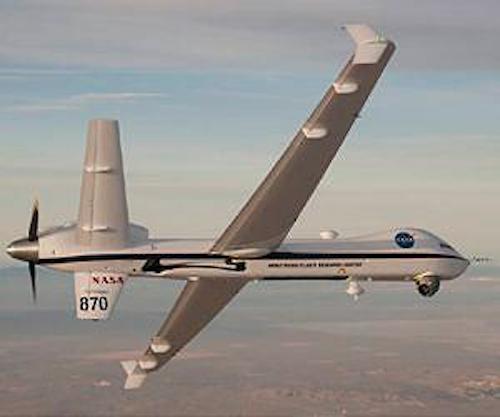.

The use of unmanned aircraft systems (UAS) is rising rapidly worldwide. Long known only for their military applications, UAS are increasingly being deployed by civilian governments for use in scientific research, climate change research, and humanitarian relief operations.
As detailed in a recent article from Northern Sky Research, the number of UAS dedicated to civilian applications is expected to triple by 2023. The U.S. leads the world in civilian government use of UAS. For example, NASA's Armstrong Flight Research Center operates a Northrop Grumman Global Hawk for high-altitude, long-duration Earth science missions. The Global Hawk has contributed greatly to NASA's study of climate change due to its unique ability to operate in the upper stratosphere.
NASA's Science Mission Directorate has teamed with the National Oceanic and Atmospheric Administration (NOAA) and the Department of Energy to use the Global Hawk for Earth observation research. Initial operational capability for Global Hawk science missions began in 2010.
A portable ground control station is functioning and has supported operations originating outside the continental United States. A permanent ground control station located at NASA's Wallops Flight Facility in Wallops Island, Virginia, was used to support the Hurricane and Severe Storm Sentinel multi-year study from 2012 - 2014 over the Atlantic Ocean. Future hurricane studies in partnership with NOAA are planned in both the Atlantic and Pacific oceans using the Global Hawk.
As detailed in Fast Company magazine, NASA also uses a General Atomics Predator UAS christened Ikhana, to track forest fires and also to test tracking technology that will eventually allow UAS to share the skies with conventional aircraft.
The ability of UAS to autonomously fly long distances, remain aloft for extended periods of time, and carry large payloads brings a new capability to the science community. The unmanned vehicles are effective for measuring, monitoring and observing remote locations of Earth not feasible or practical with piloted aircraft, most other robotic or remotely operated aircraft, or space satellites. The use of UAS to facilitate communications to underserved regions around the world is also anticipated to be a strong growth area.
According to NSR: "The use of UAS for communication relay is well understood, and architectural studies have been conducted for integrating stratospheric UAS with LEO and GEO communication satellites for localized high quality service. Despite none of these studies leading to implementation, the announcements and investment by Internet companies such as Facebook and Google in High Altitude Long Endurance (HALE) UAS for data connectivity globally has generated renewed interest in this concept."
Clearly UAS are incredibly versatile machines that deliver benefits far beyond their use in national defense. As their civilian government and commercial use continues to expand, they will improve the lives of millions of people around the globe.
Quelle: SD
4633 Views
